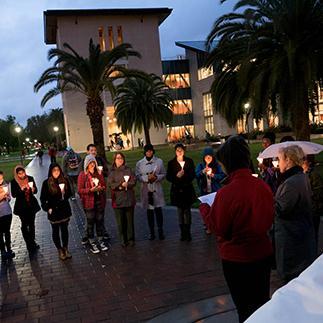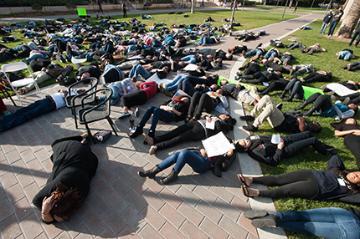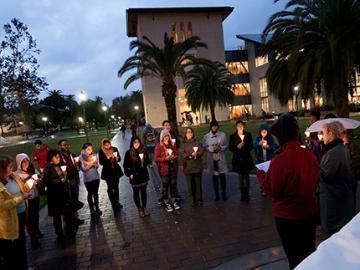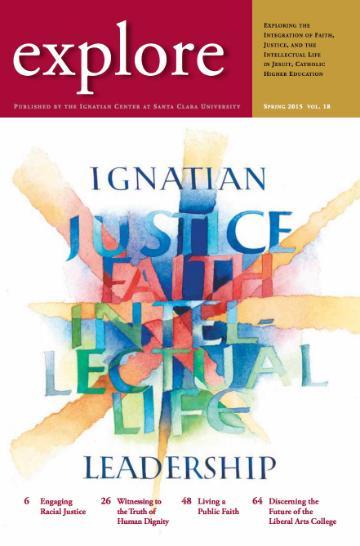
Learning How to Die
A Response to Cornel West
By Jade Agua
Program Director, Office of Multicultural Learning,
Santa Clara University
“Because any time I examine an assumption, a presupposition, any time I examine a prejudice or prejudgment that I have and I’m willing to give it up, that’s a form of death. And there is no maturation, there’s no growth, there’s no development without death.”
—Dr. Cornel West, Fall 2014 Bannan Institute Lecture
Black Prophetic Fire radiated from Dr. West as he carried on the messages of great leaders past. The last few words of the excerpt above simmered in his mouth before he doled out each syllable, carefully and deliberately. Sparks flew out into the audience and lit fires in our hearts. While Dr. West speaks of a metaphoric death here, it is the actual death of two black men, Michael Brown and Eric Garner, and their eventual denial of justice that ignited a series of events on campus at Santa Clara University (SCU) last fall.
On November 24, 2014, a St. Louis county grand jury did not indict white Officer Darren Wilson, who shot and killed black unarmed teen Michael Brown in Ferguson, Missouri in August 2014. As racial tensions exploded in Ferguson, and eventually swept across the nation in the days to follow, various SCU departments collaborated to provide support to our campus community. A special intention liturgy was held on December 2, 2014, followed by an interfaith reflection, intergroup dialogue, and a candlelight vigil for Michael Brown. It was a rainy, solemn evening as a group of about 15 students, staff, and faculty gathered to remember Michael Brown.

The next day, on December 3, 2014, a Staten Island grand jury declined to indict Officer Daniel Pantaleo whose chokehold on unarmed Eric Garner led to his death, which had been ruled a homicide. That decision set off another wave of protests across the country and on December 5, 2014 our campus community came together again at 11 a.m. for 11 minutes of silence in honor of Eric Garner for the 11 times he said “I can’t breathe” before he died. This time the number of people present grew to 50.
Campus fell quiet as students departed for winter break. On January 19, 2015 a Justice Matters Rally was held on SCU’s campus, in solidarity with the #BlackLivesMatter movement and in honor of Martin Luther King Jr. Day.5 And this time, over 300 community members were in attendance, including many senior campus leaders and visitors. One poignant moment was when everyone in attendance participated in a “die-in” and laid on the ground for 4 1/2 minutes to represent the 4 1/2 hours that Michael Brown’s body laid in the street. As I lay there “dying,” Dr. West’s words were echoing in our community and the fire in my heart was stoked once more.
I often joke that everybody dreads when I facilitate workshops because I prompt us to discuss uncomfortable, unpopular topics—race, class, gender, sexual orientation—as they relate to privilege and oppression. In our work through the Office for Multicultural Learning, I have discovered that “teaching how to die” is as difficult as “learning how to die.” The process is nonlinear, intangible, and emotionally tolling. At worst, the process can seem extremely hopeless and futile when working with those unwilling, or unready, to acknowledge their privilege or recognize systemic oppression. At best, the process can be incredibly rewarding and indemnifying if you’re fortunate enough to witness a subtle, positive change in someone’s mind or heart.
I humbly highlight three intentional actions which I believe to be critical to “dying” in the way that Dr. West suggests is needed in order for us to mature, grow, and develop as individuals. For social justice educators, there is nothing particularly new or improved about these concepts. But when learning or teaching how to die, it is imperative to:
Light A Fire. Black Prophetic Fire is not something I can ever claim to wield as a Filipino-Chinese American. But there are at least two types of related fires that I have experienced and seek to ignite in others. One is a fire of righteous anger and indignation; the other is a fire of deep love and compassion for others. Both spark the flame. Both can burn away ignorance and fuel a genuine passion for equity and social justice.
Recognize Your Privilege. Peggy McIntosh describes white privilege as an “invisible knapsack.” And guess what?—the invisible knapsack comes in different styles including but not limited to: male privilege, straight privilege, upper class privilege, and cisgender privilege, just to name a few. Anyone who denies their privilege is perhaps inadvertently, or potentially intentionally, oppressing others. Self-awareness is only the first step of becoming a social justice ally, hopefully to be followed by gaining more knowledge about what you didn’t know that you didn’t know, and then developing the skills needed to subvert the hegemonic paradigm.
Shift The Paradigm. Post-Civil Rights Act of 1964, discrimination may be illegal but it still remains to be dismantled. The legacies of slavery and segregation live on as 70 percent of all men imprisoned are Black or Latino.7 Our (in)justice and (mis)education systems are not broken; they were built to privilege some and oppress others. As social activist Grace Lee Boggs describes: “We need much more than ‘reform.’ We need a paradigm shift in our concept of education.”8 We need to think differently, critically, and creatively to be catalysts for change.
Dr. West lit a fire on SCU’s campus and the evidence of that continues to burn on. A coalition of student organizations and university departments launched a campus-wide campaign called “Beyond Guilt: Solidarity through Action” which engages students in “defining, claiming, and mobilizing their privilege.” Looking ahead, and higher up the administrative ladder, I wonder: How can we further enact the Jesuit values we espouse and upon which all of our institutions are founded? In the words of the 32nd General Congregation of the Society of Jesus, “We can no longer pretend that the inequalities and injustices of our world must be borne as part of the inevitable order of things. It is now quite apparent that they are the result of what man himself, man in his selfishness, has done.” May our fires continue to burn away the constructs of privilege and oppression, and make way for a new paradigm of equity and justice!

Endnotes
Jade Agua currently serves as Program Director for the Office for Multicultural Learning at Santa Clara University and is originally from East Side San Jose, California. She is a fourth generation Filipino-Chinese American whose family immigrated to the United States through Hawai’i. Prior to coming to Santa Clara University, Jade worked at the University of Southern California in the School of Cinematic Arts and Asian Pacific American Student Services. Jade earned her B.A. in Sociology and Master’s in Public Administration at the University of Southern California
- Cornel West, “Black Prophetic Fire: Intersections of Leadership, Faith, and Social Justice,” lecture, 2014–2015 Bannan Institute: Ignatian Leadership series, October 3, 2014, Santa Clara University. A video of the full lecture is available online at: scu.edu/ic/publications/videos.cfm.
- Monica Davey and Julie Bosman, “Protests Flare After Ferguson Police Officer Is Not Indicted,” New York Times (24 November 2014), accessed 9 February 2015, available at www.nytimes.com/2014/11/25/us/ferguson-darren-wilsonshooting-michael-brown-grand-jury.html.
- Santa Clara University’s Campus Ministry, Office for Diversity and Inclusion, Office for Multicultural Learning, and Office of Student Life collaborated to provide support to our campus community.
- J. David Goodman and Al Baker, “Wave of Protests After Grand Jury Doesn’t Indict Officer in Eric Garner Chokehold Case,” New York Times (3 December 2014), accessed 9 February 2015, available at: www.nytimes.com/2014/12/04/ nyregion/grand-jury-said-to-bring-no-charges-in-staten-islandchokehold-death-of-eric-garner.html?_r=0.
- Santa Clara University’s Office of Undergraduate Admission and the Office for Diversity and Inclusion took the lead on organizing this event.
- Peggy McIntosh, “White Privilege and Male Privilege: A Personal Account of Coming to See Correspondences Through Work in Women’s Studies,” print, (Wellesley: Center for Research on Women, 1988), available at: www.collegeart.org/ pdf/diversity/white-privilege-and-male-privilege.pdf
- Michelle Alexander, The New Jim Crow: Mass Incarceration in the Age of Colorblindness (New York: The New Press, 2012).
- Grace Lee Boggs and Scott Kurashige, The Next American Revolution: Sustainable Activism for the Twenty-First Century (Berkeley: University of California Press, 2012), 136.
- For more information on this coalition see Santa Clara University’s student newspaper story on this initiative here: thesantaclara.org/program-seeks-to-go-beyond-guilt-byempowering-students. This project was organized by Santa Clara University’s Multicultural Center and Santa Clara Community Action Program (SCCAP) in partnership with numerous campus programs, groups, and departments.
- General Congregation 32, “Our Mission Today: The Service of Faith and the Promotion of Justice,” (1975) in Jesuit Life & Mission Today: The Decrees of the 31st – 35th General Congregations of the Society of Jesus, ed. John W. Padberg, S.J. (St. Louis: The Institute of Jesuit Sources, 2009), GC32, D. 4, B.27.
